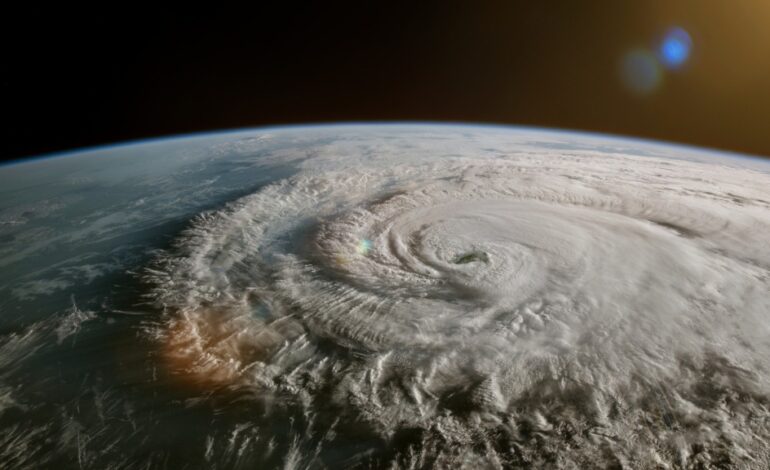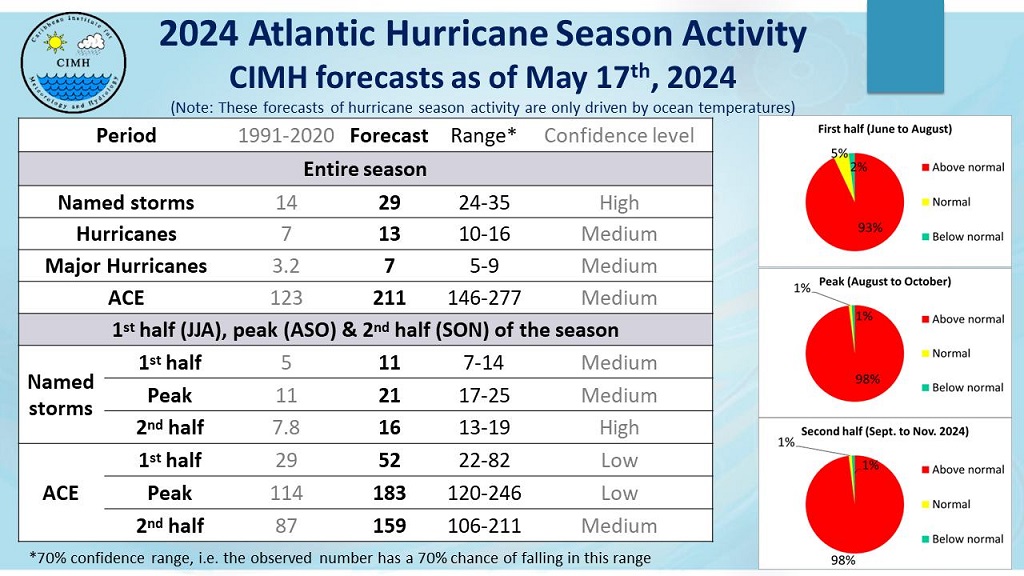Caribbean: Forecasters predict ‘hyperactive’ hurricane season

Regional forecasters Thursday predicted a “hyperactive” 2004 Atlantic Hurricane Season with up to 29 named storms, 13 of which are likely to become hurricanes, including seven major hurricanes.
The Barbados-based Caribbean Institute of Caribbean Institute for Meteorology and Hydrology (CIMH), presenting its Wet/Hurricane Season Caribbean Climate Outlook Forums (CariCOF), said historical activity in the region is similar to the years 2010, 2013, 2020 and 2023.
It said modules suggest a 66 per cent chance of at least one major hurricane tracking through the Caribbean, adding that 2024 resembles 2010, which began as the driest year in the eastern Caribbean but ended as the wettest on record, including the deluge and devastation wrought by Hurricane Tomas.

Presenting the outlook, Specialist Meteorologist at Hydrometeorological Service of Guyana, Komalchand Dhiram, said that Saharan dust is likely to impact cyclone activity during the earlier part of the hurricane season.
“… with no intrusion or very limited intrusion of the Saharan dust, a hyperactive 2024 Atlantic Hurricane season is anticipated,” he said, noting that the CIMH is only able to forecast Saharan dust intrusion up to two weeks in advance.
“If there is to be frequent Saharan dust, it will delay the onset of these activities, but not necessarily reduce the impact or the intensity of these activities. And that is because as we move away from August, the intrusion of Saharan dust decreases,” Dhiram explained.
He said that historically, the Caribbean sees an average of 14 named storms, seven hurricanes and three major hurricanes, adding that different forecasting agencies had settled on similar numbers.
Last month, Colorado State University, in its outlook, predicted 23 named storms, 11 hurricanes and five major hurricanes, the same as for Tropical Storm Risk’s forecast released four days later.
For The Weather Co., the forecast is 25 named storms, 12 hurricanes and six major hurricanes, according to its May 16 outlook.
“Looking at these numbers here, there is a high consensus of approximately in the mid-20s named storms, of which close to 13 are hurricanes and major hurricanes, seven,” Dhiram said.
CIMH climatologist, Dr. Cédric Van Meerbeeck, who also spoke at the forum, urged participants not to allow the forecast to give them “nightmares”.
“It’s not looking good. We all realise that. What’s more important is that we understand together, what we’re going to face what we’re likely to face, and how we’re going to solve the problems that are coming along with it,” Van Meerbeeck said.
He urged participants to remember that the record warmth that the region is experiencing is likely to continue.
“That means lots of excessive heat. … because of all the heat in the ocean that needs to exit the ocean, the hurricane season forecasts are showing hyperactive season,” he said, noting that there can be an interplay between the Saharan dust and cyclone activity.
“The more dust episodes we have, the weaker the first half of the hurricane season will be. But the second half shouldn’t be affected too much. So it’s still going to be active during the peak of the season and after that.”
Van Meerbeeck said that Saharan dust could also affect flooding in the region.
“Unless we get a lot of dust episodes, we’re gonna see lots of episodes of flood-creating or flood-triggering extreme rainfall,” he said.
“Drought relief is coming as soon as the wet season starts. But, unfortunately, because we have the inability at this time to predict dust one season in advance, we can’t tell you when exactly this wet season is starting this year.”
He however, noted that in several Leeward Islands, the rains return “with a bang” and some people may say this means a replenishing of the water that the heat sucked out of the soil.
“But not so much,” Van Meerbeeck said, adding that if the soil is particularly dry and the rain comes heavily, it will simply run off.
“So unless we find a way to capture that water, we still gonna be having only progressive drought relief.”
Fielding questions about a potentially hyperactive hurricane season, Van Meerbeeck said people should not be frightened.
“Don’t be frightened, be prepared. And if, like me, you believe in God, you pray as well. But be prepared is the answer.”
He noted that there is no guarantee that being prepared will save someone from a category 5 hurricane or the deepest flood ever.
“But it does make it safer in general. So be prepared,” he said, noting that Hurricane Tomas, in 2010, was fuelled by the same climatic conditions being seen this year but there is no way to say if 2024 would be a repeat.
“I’d be a trillionaire if I could, who could say there’s gonna be a hurricane Tomas this year,” Van Meerbeeck said.

Head of meteorology and hydrology at CIMH, Adrian Trotman,said he was concerned about the impact of the atmosphere releasing all of the pent-up energy after the Saharan dust subsides.
“Normally, it releases itself. We have that as well. That is something that also concerns me. That happened in 2010. The Atlantic just said, ‘Wow, good, the drought is done, the El Nino is done. It’s time for me to show up.’ And it did show up in significant ways. Very, very intense, rapid change. Are we going to see that this year?” Trotman said.
As regards the rainy season, Dhiram said the CIMH is forecasting a higher probability for above-normal rainfall.
From June to August, forecasters are predicting extremely high flash flood potential in The Bahamas, Belize, Cayman IsIands, Dominican Republic, the Guianas, Jamaica; high to extremely high potential in Cuba, the Lesser Antilles; moderate to high potential in the ABC Islands.
“The farther away we are from today, the forecast skill weakens. So, we urge that you pay keen attention as these forecasts update monthly. So, these probabilities you can be aware of how they change.”





